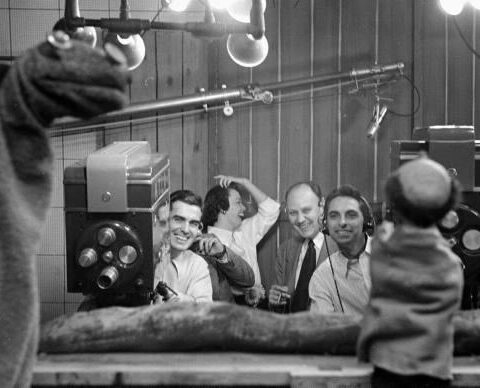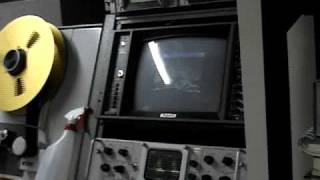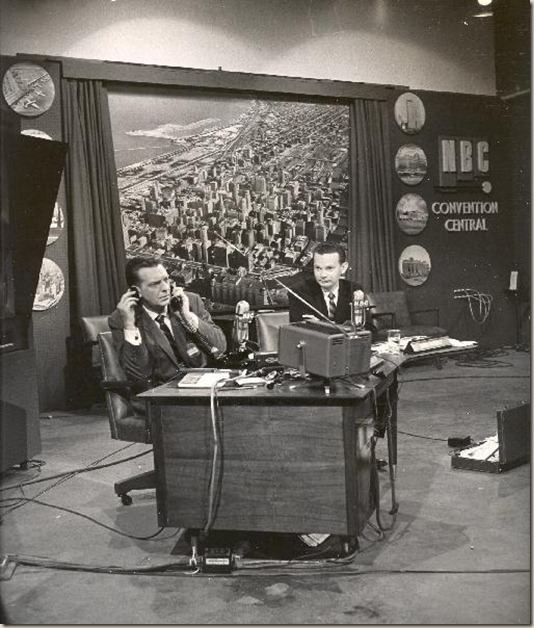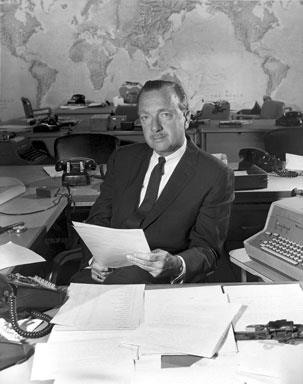- Home
- TV History
- Network Studios History
- Cameras
- Archives
- Viewseum
- About / Comments
Skip to content






































Posts in Category: TV History
Page 131 of 136
« Previous
1
2
3
4
5
6
7
8
9
10
11
12
13
14
15
16
17
18
19
20
21
22
23
24
25
26
27
28
29
30
31
32
33
34
35
36
37
38
39
40
41
42
43
44
45
46
47
48
49
50
51
52
53
54
55
56
57
58
59
60
61
62
63
64
65
66
67
68
69
70
71
72
73
74
75
76
77
78
79
80
81
82
83
84
85
86
87
88
89
90
91
92
93
94
95
96
97
98
99
100
101
102
103
104
105
106
107
108
109
110
111
112
113
114
115
116
117
118
119
120
121
122
123
124
125
126
127
128
129
130
131
132
133
134
135
136
Next » TV’s First Weekly, One Hour Musical Show
On September 10, 2012
- TV History
On June 20, 1948 ‘The Fred Waring Show’ debuted on CBS. It is believed to be the first weekly one hour music show, however, the show was cut to a half hour in ’52. For the first few years, it aired just after the Ed Sullivan Show, at 9 on Sunday nights.
Below is a video compilation from the show and you may be as surprised as I was to see what’s here. The Blues In The Night piece has some awesome production values for 1948, and the last piece has a remarkable sax player dancing, twirling rope and playing all at once…quite vaudevillian. I think you’ll enjoy this…really.
Republican National Convention: 1940
On September 9, 2012
- TV History
Republican National Convention: 1940
This is an RCA Iconoscope camera from experimental station W3XE (now KYW) covering the RNC in Philadelphia for NBC in June of 1940, where Wendell Willkie was chosen to run against FDR.
The channel 3 facility in Philadelphia is one of the world’s oldest television stations. It began in 1932 as W3XE and was owned by the Philco Corporation. In 1941, it began sharing programs with W2XBS (later WNBT and now WNBC-TV) in New York City, becoming NBC’s second television affiliate, and creating a link between the station and the network that would last for 54 years.
On July 1, 1941, W3XE received a commercial license, the third in the United States, and the first outside New York City. The station signed on for the first time on September 1 as WPTZ. Like others, they significantly cut back operations after the U.S. entered World War II, but returned to a full schedule in 1945. It then became one of three stations (along with WNBT and WRGB in Schenectady, New York) that premiered NBC’s regular television service in 1946. The Westinghouse Electric Corporation, owner of Philadelphia’s NBC radio affiliate KYW (1060 AM), purchased WPTZ in 1953 for a then-record price of $8.5 million.
ULTRA RARE: Sid Caesar’s First Series ‘The Admiral Broadway Review’…
On September 8, 2012
- TV History
ULTRA RARE: May 1949, Sid Caesar’s First Series
‘The Admiral Broadway Review’
Caesar began his television career when he made an appearance on Milton Berle’s Texaco Star Theater. In early 1949, Sid and producer Max Liebman met with Pat Weaver, president of television at NBC (and father of Sigourney Weaver), which led to Caesar’s appearance in his first series, ‘The Admiral Broadway Revue’ which also included Imogene Coca.
Above is a photo of Sid on stage at NBC’s first television converted theater, The International at 5 Columbus Circle. When NBC first began to use the theater with the “Admiral Broadway Revue” show, it was a three camera show done with a mobile unit feeding the show back to 30 Rock on an AT&T line. By the time YSOS debuted, NBC had installed a control room and four permanent RCA TK30 camera chains.
The Friday night show was simultaneously broadcast on NBC and the DuMont network. Odd, but it was done so the show to be carried on the only TV station then operating in Pittsburgh, DuMont’s WDTV. The show was an immediate success, however, its sponsor, Admiral, an appliance company, could not keep up with the demand for its new television sets, so the show was cancelled after 26 weeks. According to Caesar, an Admiral executive later told him the company had the choice of building a new factory or continuing their sponsorship of Revue for another season.
On February 23, 1950, Caesar appeared in the first episode of ‘Your Show of Shows‘, a Saturday night 90-minute variety program also produced by Max Liebman.


‘Time For Beany’
On September 8, 2012
- TV History
‘Time For Beany’
Below, Cecil (Stan Freburg) and Beany (Daws Butler) entertain an audience of all ages in 1950, while just on the other side of the wall, two KTLA TK10s capture the fun. Even Albert Einstein admitted that he watched the show. The original puppet show version aired from Feb 49 till late in 54. It returned in ’59 in cartoon form.
Originally created as a children’s show, the genius of the creators and writers soon became evident and the show began attracting more adults than children. When it was Time For Beany, the entire family was crowded around the set. The crux of Beany’s success was the intermingling of current political issues and fiascos that appeared as thinly veiled plots easily recognizable as lampoons of current political issues or personalities. The Shakespearian asides given by Beany, Cecil and the rest of the cast were magnificent and often alluded to embarrassing public fiascos or personages, on which the adult audience immediately picked up. That those gems of wisdom are lost forever is a great literary tragedy…there were just a few Keniscopes of the show saved.
Hallmark Hall Of Fame: ‘Kiss Me Kate’, November 1958
On September 8, 2012
- TV History
This was a live color broadcast from NBC’s Brooklyn Studios and it was a huge production with lots of sets. Most of the actors in this musical were members of the original Broadway cast, except a very young Jack Klugman who sang and danced. I would have loved to been there for a live color broadcast. You too?
Need A Lift Dinah?
On September 8, 2012
- TV History
Need A Lift Dinah?
In a 1952 episode of the twice weekly, 15 minute ‘Dinah Shore Show’, our star hitches a ride on a Panoram dolly with an extra sideboard.
In ’56, Shore began hosting a monthly series of one-hour full-color spectaculars as part of NBC’s ‘The Chevy Show’ series. These proved so popular that the show was renamed The Dinah Shore Chevy Show the following season, with Shore becoming the full-time host, helming three out of four weeks in the month.
Broadcast live and in NBC’s famous ‘Living Color,’ this variety show was one of the most popular of the 1950s and early 1960s. ‘The Dinah Shore Chevy Show’ ran through the 1961-1962 season, after which Chevrolet dropped sponsorship, and Shore hosted a series of monthly broadcasts simply called ‘The Dinah Shore Show.’ Over twelve seasons, from 1951 to 1963, Dinah Shore made 125 hour-long programs and 444 fifteen-minute shows.
ULTRA RARE: Classic Photo
On September 8, 2012
- TV History
ULTRA RARE: Classic Photo
Here are two of America’s most famous clowns ever, together…Emit Kelly and Clarabell. The photos is on the set of a 1949 WNBT show who’s name, I think, is ‘Television Screen Magazine’ and this is most likely in famed NBC Studio 3H. The lady is co host, Ursula Halloran.
May 8, 1945, Victory In Europe
On September 7, 2012
- TV History
May 8, 1945, Victory In Europe
To celebrate, WNBT broadcast hours of news coverage on the end of World War II in Europe with remotes from around New York City. Here, we see an RCA Orthicon camera atop the marquee of the Astor Hotel in panning the happy crowd below. This vivid coverage was a prelude to television’s rapid growth after the war ended.
In the spring of 1946, the station changed its frequency from channel 1 to channel 4 after VHF channel 1 was removed from use for television broadcasting.
ABC’s First Series, ‘Hollywood Screen Test’
On September 7, 2012
- TV History
ABC’s First Series
‘Hollywood Screen Test’ was the first network series broadcast on ABC-TV, and started on day one along with the brand new network.
Debuting on 15 April 1948, and hosted first by Bert Lytell and then Neil Hamilton, who is shown above, ‘Hollywood Screen Test’ sought to give exposure to many up-and-coming actors who were looking for their big break. The relatively unknown actors would be picked to guest star on the show, then they would have half-hour scenes of dialogue with established stage and screen actors.
Among the stars discovered on Hollywood Screen Test are, Grace Kelly, Jack Klugman, Pernell Roberts, and Jack Lemmon. FYI, WABC started life as WJZ TV. Thanks to Bryan Durr for the helping hand.
John Vassos: Transparent Television
On September 7, 2012
- TV History
John Vassos: Transparent Television
Yesterday, I posted a story on industrial design pioneer John Vassos and his influence on the RCA Television cameras. Today, I thought I’d show you the plexiglass TRK 12 receiver he built for the 1939 World’s Fair. Vassos helped design the RCA building there, and all of the display areas.
One That Never Made It
On September 7, 2012
- TV History
One That Never Made It
RCA once disclosed that they had spent over $200,000,000 developing color television. I don’t doubt it…it was expensive work to do and this Tri Color Vidicon tube is proof. Here in this photo from April of 1953, Dr. Paul Weimer of RCA Labs poses with the new tube idea and the color camera that never was. By ’55, the concept was abandoned due to the cost involved.
THE BIRTH & SHORT HISTORY OF ELECTRONIC TELEVISION!
On September 7, 2012
- TV History
Friday, September 7th, 2022 was the 95th anniversary of the invention of electronic television. In 1927, 21 year old Philo T. Farnsworth and his 18 year old bride, Pem, demonstrated their invention to two Crocker Bank investors in the second floor lab of a rented garage at 202 Green Street in San Francisco.
That day, Farnsworth’s image dissector camera tube transmitted its first image, a simple straight line. The source of the image was a glass slide, backlit by an arc lamp. An extremely bright source was required because of the low light sensitivity of the design. By 1928, Farnsworth had developed the system sufficiently to hold a demonstration for the press. His backers had demanded to know when they would see dollars from the invention, so the first image shown was, appropriately, a dollar sign.
In 1929, the design was further improved by elimination of a motor-generator, so the television system now had no mechanical parts. That year, Farnsworth transmitted the first live human images using his television system, including a three and a half-inch image of his wife Elma (“Pem”), with her eyes closed because of the blinding light required.
Many inventors had built electromechanical television systems prior to Farnsworth’s seminal contribution, but Farnsworth designed and built the world’s first working all-electronic television system, employing electronic scanning in both the pickup and display devices. He first demonstrated his system to the press on September 3, 1928, and to the public at the Franklin Institute in Philadelphia on August 25, 1934.
In 1930, Vladimir Zworykin, who had been developing his own all-electronic television system at Westinghouse in Pittsburgh since 1923, but which he had never been able to make work or satisfactorily demonstrate to his superiors, was recruited by RCA to lead its television development department. Before leaving his old employer, Zworykin visited Farnsworth’s laboratory and was sufficiently impressed with the performance of the Image Dissector that he reportedly had his team at Westinghouse make several copies of the device for experimentation. Zworykin later abandoned research on the Image Dissector, which at the time required extremely bright illumination of its subjects to be effective, and turned his attention to what would become the Iconoscope.
In 1931, David Sarnoff of RCA offered to buy Farnsworth’s patents for $100,000, with the stipulation that he become an employee of RCA, but Farnsworth refused. In June of that year, Farnsworth joined the Philco company and moved to Philadelphia along with his wife and two children. RCA would later file an interference suit against Farnsworth, claiming Zworykin’s 1923 patent had priority over Farnsworth’s design, despite the fact they could present no evidence that Zworykin had actually produced a functioning transmitter tube before 1931.
Farnsworth had lost two interference claims to Zworykin in 1928, but this time he prevailed and the U.S. Patent Office rendered a decision in 1934 awarding priority of the invention of the image dissector to Farnsworth. RCA lost a subsequent appeal, but litigation over a variety of issues continued for several years with Sarnoff finally agreeing to pay Farnsworth royalties. Zworykin received a patent in 1928 for a color transmission version of his 1923 patent application, he also divided his original application in 1931, receiving a patent in 1935, while a second one was eventually issued in 1938 by the Court of Appeals on a non-Farnsworth related interference case, and over the objection of the Patent Office.
The photo shows Philo and Pem at the demonstration of a 1935 version of his television camera.
WOW! Look at this!
On September 6, 2012
- TV History
WOW! Look at this! Followup to yesterday’s classic Murrow photo
SEE IT NOW, Season 1, Episode 6 Late December, 1951: Studio 41 CBS Studios, Grand Central Terminal.
The first few minutes of this is really instructive on the show’s production. As I had assumed in yesterdays post, they actually did the show from the control room for the first season, but would later move it to ‘the other side of the glass’, but it would still have a distinct control room feel. Here, again, you can see Don Hewitt directing behind Murrow. For more, check out the great rundown below.
http://www.museum.tv/eotvsection.php?entrycode=seeitnow
See it now [English] Part 1 of 3! Full lenght & High Quality! …SUBSCRIBE FOR MORE… English: The show was an adaptation of radio’s Hear It Now, also produ…
John Vassos and RCA ‘Television’
On September 6, 2012
- TV History
John Vassos and RCA ‘Television’
If you look where Milton’s hand is, you are seeing the hand of one of America’s first industrial designers…John Vassos. The ‘Television’ and ‘Color Television’ badges that adorn all the early RCA cameras and telecine equipment was designed by Mr. Vassos. The classic look and style of the TK40/41 was also a part of his contribution to form and function. I think he also had a hand in the look of the TK10, TK30 and TK11/31s. The chrome and red stripe on the TK10s is very Vassos looking. He influenced, and was influenced by the art decco style.
His association with RCA began during the design phase of the RCA exhibits and building at the 1939 World’s Fair and lasted into the 1970s. Some of his influence in style migrated to the RCA consumer products too, like radio and TV set design.


Ampex VR 1200, Up Close and Personal
On September 6, 2012
- TV History
Ampex VR 1200, Up Close and Personal
For those who have never seen a big Quad videotape machine in action, here’s your big chance. As you’ll see, it’s not as easy as just pressing the ‘Play’ button.
We forget sometimes how far video technology has come in just the past few years. I recently needed to get some video from an old 2″ Quad videotape and disco…
ULTRA RARE CLASSIC PHOTO!
On September 5, 2012
- TV History
ULTRA RARE CLASSIC PHOTO!
See the just added video…see it here!
Together, working on a very early 1952 edition of ‘See It Now’, we see two legends of CBS News…Edward R Murrow, and, the shows first director, Don Hewitt. This is the first and only image I have ever seen of both of them together in the studio.
This looks like there is actually a camera in the control room, so this may even be a rehearsal from the first broadcast as they kind of set the stage for the viewers.
Murrow’s set would later move to the other side of the glass in later years, but in the studio it would remain very “control room looking”
Smoke and Mirrors
On September 5, 2012
- TV History
Smoke and Mirrors
A while back, there were some questions about an Ernie Kovacs photo posted here that had him pouring water (that was missing the glass), on a titled gimble set. The set was at quite an angle but the viewfinder shot was level…how? Mirrors. This old style system is still around and in use mostly for cooking segments, but the mirror arrangement can also be flipped to make the shot look like the camera is floor level, like for dance numbers. Now you know!
The 1956 Conventions: The Birth Of A Team
On September 5, 2012
- TV History
The 1956 Conventions: The Birth Of A Team
In 1956, both the Democratic (San Francisco) and Republican (Chicago) political conventions were big events for television. To anchor at both, NBC paired Chet Huntley and David Brinkley. They were well received and the rest, as they say, is history.
By 1956, NBC executives had grown dissatisfied with Swayze in his role anchoring the network’s evening news program, which in ’55 fell behind its main competition, CBS’s Douglas Edwards with the News. Network executive Ben Park suggested replacing Swayze with Chet Huntley and David Brinkley. Bill McAndrew, NBC’s director of news (later NBC News president), had seen a highly rated local news program on NBC affiliate WSAZ-TV in Huntington, West Virginia, with two anchors reporting from different cities.
On October 29, 1956, he replaced ‘The Camel News Caravan’ with ‘The Huntley-Brinkley Report’, with Huntley in New York and Brinkley in Washington. Producer Reuven Frank, who had advocated pairing Huntley and Brinkley for the convention coverage, thought using two anchors on a regular news program “was one of the dumber ideas I had ever heard.” Nonetheless, on the day of the new program’s first broadcast, Frank authored the program’s closing line, “Good night, Chet. Good night, David. And good night, for NBC News.” This exchange became one of television’s most famous catchphrases even though both Huntley and Brinkley initially disliked it.
Huntley handled the bulk of the news most nights, with Brinkley specializing in Washington-area news. The closing credits music for the broadcast was the second movement of Beethoven’s Ninth Symphony, from the 1952 studio recording with Arturo Toscanini conducting the NBC Symphony Orchestra.
SEPTEMBER 4, 1962…CBS NEWS EXPANDS TO 30 MINUTES
On September 5, 2012
- TV History
On September 4, 1962 CBS became the first network to air a half hour of television news. Walter Cronkite had replaced the original anchor, Douglas Edwards, in April of that year.
A week later, The Huntley-Brinkley Report at NBC went to a half hour as well.
On May 3, 1948, Douglas Edwards began anchoring ‘CBS Television News’, a regular 15-minute nightly newscast. It aired every weeknight at 7:30 PM, and was the first regularly scheduled television news program.
In 1950, the name was changed to ‘Douglas Edwards With The News’, and the following year, it became the first news program to be broadcast on both coasts, thanks to a new coaxial cable connection, prompting Edwards to use the greeting “Good evening everyone, coast to coast”.
WNBT (NBC), 1941 Rate Card – Part A
On September 4, 2012
- TV History
WNBT (NBC), 1941 Rate Card – Part A
When I first saw this, I was stunned. At first, I thought they wanted $120 for a 60 second spot, but no…it was $120 per hour to sponsor a show. That’s more like it, especially when you consider that there were only 2,000 sets in the NYC area. When you see (in Part B below) what shows were on, think again about this rate card.
Here are some cost of living prices from 1941:
Average Cost of new house $4,075.00
Average wages per year $1,750.00
Cost of a gallon of Gas 12 cents
Average Cost for house rent $32.00 per month
Beautyrest mattress $39.50
Average Price for a new car $850.00
Page 131 of 136
« Previous
1
2
3
4
5
6
7
8
9
10
11
12
13
14
15
16
17
18
19
20
21
22
23
24
25
26
27
28
29
30
31
32
33
34
35
36
37
38
39
40
41
42
43
44
45
46
47
48
49
50
51
52
53
54
55
56
57
58
59
60
61
62
63
64
65
66
67
68
69
70
71
72
73
74
75
76
77
78
79
80
81
82
83
84
85
86
87
88
89
90
91
92
93
94
95
96
97
98
99
100
101
102
103
104
105
106
107
108
109
110
111
112
113
114
115
116
117
118
119
120
121
122
123
124
125
126
127
128
129
130
131
132
133
134
135
136
Next »